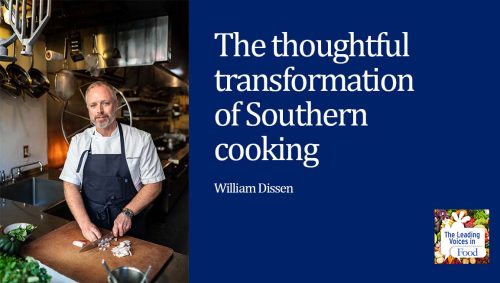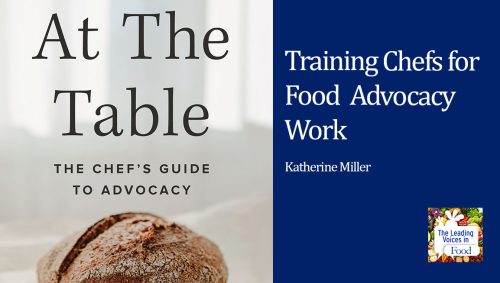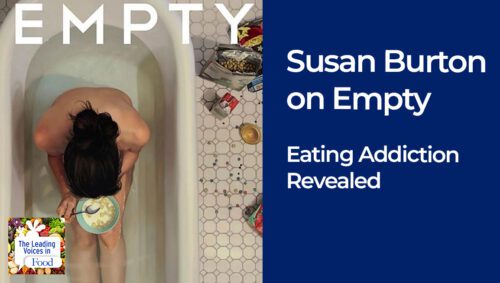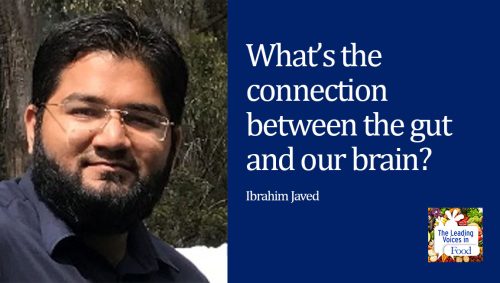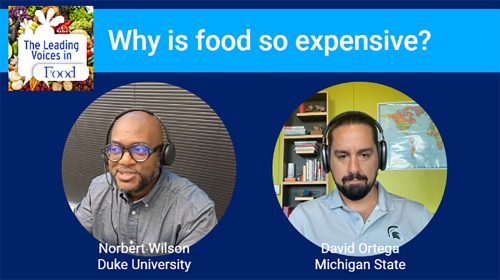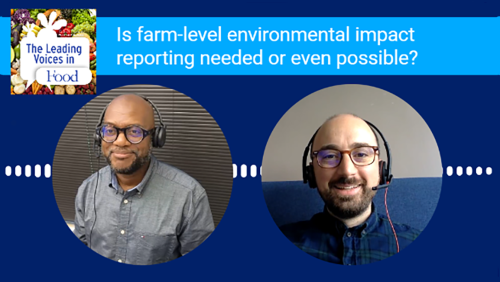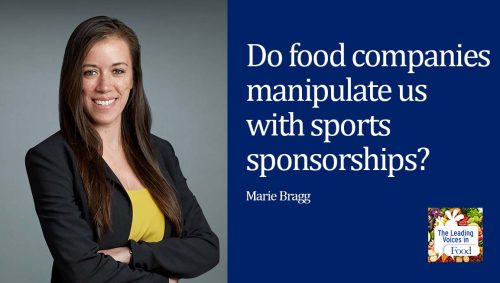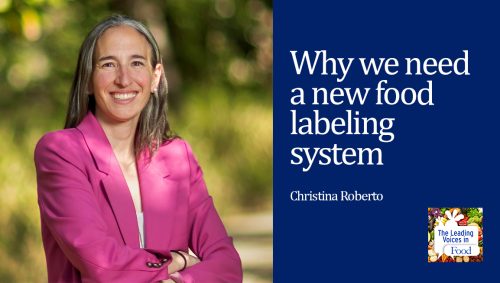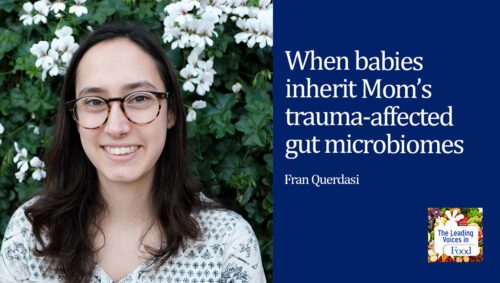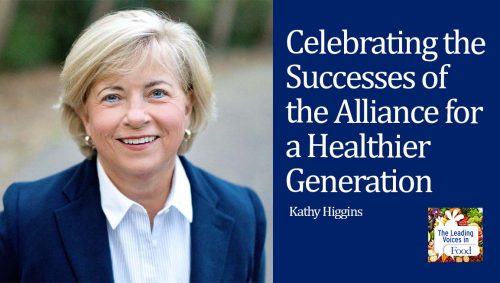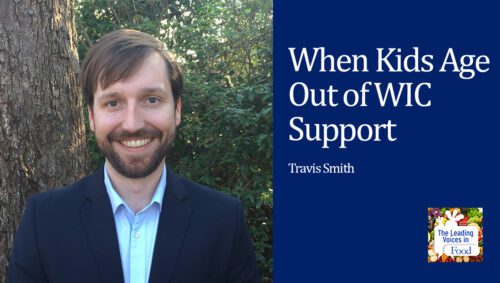The Leading Voices in Food
E245: Menus of Change Collaborative – shaping university student eating habits and careers
When you hear university dining, you likely have images in your mind of college students with trays and hand waiting in a line for a meal in a dining hall. You may even think of a food court or a trendy food hall in the cool part of town. But there is so much more happening behind the scenes. Today we will learn about Menus of Change University Research Collaborative, MCURC for short, which is a nationwide network of colleges and universities using campus dining halls as living laboratories for behavior change. The collaborative’s goals are to move people towards healthier, more sustainable and delicious foods using evidence-based research, education and innovation. Our guest today is the collaborative’s co-founder and co-director, Stanford University’s Sophie Egan.
Subscribe: Apple Podcasts | TuneIN | YouTube Music | SoundCloud | PocketCasts | Radio Public
Tags: Chefs & Food Writers | Diet & Nutrition | Food Industry Behavior & Marketing | Food, Psychology & Neuroscience | School Meals |

Sophie Egan, MPH is the Director of the Stanford Food Institute and Sustainable Food Systems at R&DE Stanford Dining, Hospitality & Auxiliaries, where she is Co-Founder and Co-Director of the Menus of Change University Research Collaborative. She is also the author of How to Be a Conscious Eater (Workman, 2020)—named one of Bon Appétit’s “Favorite New Books for Climate-Friendly Cooking and Life”—and the founder of Full Table Solutions, a consulting practice that’s a catalyst for food systems transformation. An internationally recognized leader at the intersection of food, health, and climate, Sophie is also a contributor to The New York Times Health section and Director of Strategy for Food for Climate League. Previously, Sophie served as the Director of Health and Sustainability Leadership/Editorial Director for The Culinary Institute of America’s Strategic Initiatives Group. Sophie’s writing has been featured in The Washington Post, TIME, Parents, The Wall Street Journal, Bon Appétit, WIRED, EatingWell, Edible San Francisco, FoodTank, and Sunset. She is a member of the Food System 6 Advisory Board, James Beard Foundation Sustainability Advisory Council, and the Food Tank Academic Working Group. She holds a BA with honors in history from Stanford University; an MPH with a focus on health and social behavior from UC Berkeley; and a certificate from the Harvard Executive Education in Sustainability Leadership program.
Interview Summary
I’d like you to tell our listeners a little bit more about the Menus of Change University Research Collaborative. What is it and how does it actually work?
The Menus of Change University Research Collaborative was co-founded by the Culinary Institute of America and Stanford University, two divisions there, the Stanford Prevention Research Center and the School of Medicine, and Residential and Dining Enterprises. And that should tell you something is different in our vision, which is that first and foremost, we wanted to break down silos that exist on campuses between experts in food who work in academic realms. So, researchers, faculty who may be studying food, either from one certain discipline or ideally some cases transdisciplinarily, and those who actually feed students, the experts in the dining programs on campus. And Stanford was a good place to co-found this because of this great partnership that already existed between the dining program and between Dr. Christopher Gardner at the School of Medicine. But that model has actually now been replicated. We are at 70 plus institutions, not only across the U.S., but actually increasingly internationally.
In addition to fostering that collaboration and breaking down those silos on a given campus, we really wanted to foster collaboration between universities to take what we consider kind of a plug-and-play research protocol. You know, a given design of a study that, as you said, uses campus dining halls as living laboratories and actually replicate research. So that’s what we’ve done. It’s been incredibly fun to be part of it from the beginning, and it’s been incredibly exciting and impactful because of the approach that we take. We really democratize even what it means to be a researcher, to be involved in research. We have involvement in the collaborative and in research projects from students, faculty, of course, who are critical in their expertise, but also executive chefs, nutrition and sustainability experts. And many other research collaborators who are mission aligned organizations like EAT and REFED and Food for Climate League, who bring their own kind of comparable expertise. And we all work together to shape these living lab studies and then to test those at multiple sites to see if this a more generalizable effect? Or is that something just those west coast schools work for? Or is this only something that, you know, more elite schools where students of a certain demographic really respond?
But that’s also the beauty is the diversity of the institutions that we have. Geographically, public private, small and large. And we’re really brought together by the kind of common language of what’s also in our name, Menus of Change. And these are these principles of optimizing both human and planetary health through the food on our plates.
And for us really, especially through students, changing that trajectory and cultivating the long term wellbeing of all people in the planet, one student, one meal at a time.
Wow. This sounds like a really amazing program. And I love the fact that you’re working across different types of universities across the U.S. and even outside. And it does make me believe that the findings that you have are applicable in a broader setting than if one institution does it. I can appreciate the power of the Collaborative. I want to know a little bit more about the impact of the collaborative. What has it been up to this point and in what ways have you seen this collaborative generate new ideas or new research findings?
Yes. So, we’ve got about six peer reviewed publications under our belt with more on the way. Our latest is called the University Procurement and Planetary Health Study led by Dr. Jackie Bertoldo, who was at the Johns Hopkins University and also Stanford Food Institute. But we have a number of academic publications also in the works. And then importantly, we actually have produced 13 operational publications and reports. So, what that illustrates is that we’ve come to realize that those that are collaborating have different currencies. Publishing in a peer reviewed journal, that’s what motivates academic researchers, right? That’s what’s going to enable them to invest time and resources. Fundamentally, this is primarily something that people do, in their free time, right? It’s a volunteer-based network of over 300 members. But if they’re going to work on a project, it has to have some value to their own work. But what has value to those in dining operations is implementable, real, tangible strategies, recommendations, and guidelines that translate ‘these are the findings of a certain study into what do you want me to do about it? How do you want me to change my menu, sourcing, the design of the dining hall, the choice architecture, right? The food environment itself. How do you want me to change something in the operational setup?‘ Maybe, if it has to do with food waste. All of these resources are on our website. We also have three really exciting new projects in the pipeline.
So that’s our research and publication impact to date. But I should say that importantly, it’s much more meaningful to us who take those resources and acts upon them. We know that universities are unique places to conduct research, but our research is not aimed only at the campus dining sector. It’s actually offered open source to inform and shape the entire food service industry. We have been thrilled, for example, one of our kind of flagship publications called the Edgy Veggies Toolkit has been implemented and adopted by some of the largest food service companies in the world. Think of Sodexo, Aramark, Compass, who are phenomenal members of the collaborative. Think of corporate dining programs, hospitals, hotels, elsewhere. K 12 environments. And that’s, to us, the most important kind of reach is to know that those toolkits, those resources.
Edgy Veggies was about how you could simply change the way you describe vegetable-based dishes on a menu, to use more taste focused language, to increase the appeal. We actually demonstrated you can measurably increase selection and consumption of vegetables. So, you can imagine that has applications in public health in countless settings. Even those of us trying to feed our kids. Hey, if I call tonight’s broccoli, you know, zesty orange broccoli versus just broccoli, maybe my kid will eat more of it, right? So, it has applications in countless different contexts.
Another really big area for us is our collective purchasing power. So, we learned at some point that it’s not only that these organizations, the institutions that are part of the collaborative are brought together by a desire to co create research, but it’s really that alignment on healthy, sustainable, plant forward future for the food service industry. And so we’ve actually created this collective impact initiative where it’s our combined purchasing power. We’ve now measurably reduced our combined food-related greenhouse gas emissions. By 24 percent just between 2019 and 2022, and that’s across 30 institutions, 90 million pounds of food. I mean, this is a huge outcome for us, and we’re not stopping there. We had a goal to reduce by 25 percent by 2030, and now reaching that, we’re A, enhancing the target to a 40 percent reduction by 2030. But importantly, we’re actually measuring now the uptick in diet quality. So, because human health is equally important to that sustainability part, that University Procurement for Planetary Health study that I mentioned, we’re actually able to see that if we are aligning our procurement, meaning what do we buy in the total pounds of an institution and then in the aggregate, right? How plant forward, how healthy and sustainable is that kind of portfolio, that total mix of foods that we’re purchasing? And we can actually really increase the diet quality and that kind of average health profile at the same time. So, getting that data layer is really key. And it’s the kind of area of impact that has so much momentum and will only continue into the future.
Also, lastly, just to say our student engagement numbers have really grown, and that’s critically important because educating and cultivating the next generation of food systems leaders. is also core to our work. We have our MCRC Fellows program and that has really grown to have about 30 fellows from a number of institutions all around the country. That’s another great way that anyone interested can get involved in. Students are a reason for being. So, it’s key that they see these ways to make an impact through their work as well.
I am really impressed with the improvements in lowering greenhouse gas emissions or improving sustainability of the dining facilities. How actually did you all do that? I mean, it sounds like you’re asking people to report and through that reporting, you see reduction? Can you explain?
Coming soon is our 2.0 learnings report that will answer that exact question, but we do have a 2020 version. We call it the early learnings report that shares what it sounds, you know, the early learnings of what works, what doesn’t. But what I can tell you can have been kind of the big keys to that success. First, collective target setting. We have been able to welcome institutions that really don’t necessarily have the political support, the kind of stakeholder buy in, to make a big public commitment. Some schools do, some institutions do, and that’s great. And others, they can sort of take cover, so to speak, in contributing to something where, you know. Their pace of change may be different. And so, it’s really kind of contributing to something larger than only their institution, but also having the comfort that it’s going to be fits and starts. It may not be linear. It may not be all forward. It might be a little bit backward in terms of the progress trajectory. So that’s been really key to having a real diversity of schools where it’s not only those that are at the very leading edge. And it’s in again, places that aren’t as comfortable coming out with a big splashy public wedge.
The other big thing that’s been key is that we have created a very streamlined framework for data collection. Instead of kind of saying you must submit your data for every single item you’ve ever purchased, we’ve on a smaller subset of food categories, where it’s easier for them to track, we’ve created a streamlined and standardized template for them to submit the data, and we also provide individualized reports back to that university. It’s confidential. They are the only one who gets it. And that’s very motivating because a lot of institutions don’t have that resource or that expertise to conduct that analysis to track their emissions year over year. It’s almost like getting kind of a free consultancy. But it’s what creates that reciprocity where we need their data. We need their collective contribution to the collective effort. And they’re getting something out of it because they do have to take the time to find the data and to submit it to us. And then the other thing I think has really been key is, and this was kind of the core concept of collective impact, is continuously iterating. Every year we’re listening to those involved in tweaking, you know, how we’re asking for the data, how frequently we used to ask for it twice a year, and now it’s annually, for example. So always kind of iterating, testing and iterating to make the processes mutually beneficial as possible. And then also keeping the door open for those other institutions to join. It’s kind of a cohort effect where we have some institutions that have been part of it from the beginning and others that have only been submitting data for a year and everyone is playing a role.
Great. Thank you for sharing that. I want to ask you a little bit more about your other work that you’re doing because you’re the co-director of the collaborative. You’re also the co-director of the Stanford Food Institute. Can you tell our listeners more about that institute and what you’re working on there?
The Stanford Food Institute was founded by our visionary leader, Dr. Shirley Everett, who’s Senior Vice Provost for Residential Dining Enterprises at Stanford. And she really had this vision to bring together an entire community of people to shape a better future of food for the benefit of all humanity and, and really embracing how much food is happening on the Stanford campus. To have the Stanford Food Institute be really this hub and this home for what belovedly we say at Stanford, it’s a very decentralized place. There’s a ton of entrepreneurial spirit and that’s fantastic and should be, but often we don’t know what everyone else is doing. So, it’s a great opportunity for the Stanford Food Institute to be that magnet and say, come one, come all, whatever student led group, research project, course, event, you know, we want to work with you.
So, in practice, what we really do is we work across research, education and innovation to bring together that community and work on this better future. We have a really strong focus on racial equity in the food system, as well as bold climate action. Those are kind of some cross-cutting themes.
Our R&DE (research, development, education) core values that have to do with excellence and students first, sustainability, health, deliciousness. All of those things are kind of foundational at the same time. So we actually collaborate with faculty in all seven schools, which is for me super fun because I get to learn about the business dimensions of food and the psychology and social sciences. We have the new Stanford Doerr School of Sustainability that is a very active partner. We have phenomenal partners in the School of Medicine. And when possible, of course, we bring them all together.
One really phenomenal culmination of all of those different research efforts is we host something called the Stanford Food Institute Food Systems Symposium, where every year, I like to explain it as a food systems science fair. It’s a kind of exhibition style showcase. Researchers get really creative with how they show their work. We had over a hundred researchers at our latest symposium. And it demonstrates that real diversity of disciplines and topics that, that touch food because that’s what’s so exciting about food. It touches all parts of society. That’s one big example. And then we have a number of community partnerships in the Bay Area. One is with the nonprofit Farms to Grow and we’re really committed long term to helping support black farmers, not only in California, but sharing our model for increasing supplier diversity and equitable supply chains with other institutions. So those are just two examples, but it’s really such a pleasure and an honor to lead the Stanford Food Institute. And as you can likely gather, it’s really quite complimentary to the menus of change university research collaborative as well.
I am really excited to learn about this symposium. And I got to say, I’ve worked in land grant institutions before, and I studied at land grant institutions. And so it’s interesting to hear of a school like Stanford that is not a land grant. That doesn’t have a tradition of agriculture in a narrowly defined sense engaging in this work. I mean, how is it that you’re able to find that many people? You said a hundred folks were working on different projects related to the food system. Is it just happening, and people don’t necessarily know that it’s happening and you’re able to bring them together? What’s going on there?
That’s a good question. I don’t have a scientific answer. I have a hunch. Anecdotal evidence. We’re talking about research here. So, I’ve got to be clear on my methods for answering. I’ll tell you, Norbert, so before I was in this role, one of the things I did was I taught a class at Stanford in the School of Design that was all about food systems careers. And it was essentially a stopgap because there was so much interest from undergraduate students in careers in food systems. But they didn’t know what on earth they were going to do to make money, to make a living. How were they going to tell their parents I’m going to use all this money you spent on my degree to do what exactly? There also was just not a clear sense of even what the role types were. What’s out there? What’s possible? How can I make a difference? And so that class that we co-taught for several years. And I say that because that was just an interesting signal of how many students were interested, sort of, you know, poking at the edges. But a lot of them, to be honest, I call it off ramping. They didn’t see the path. They just went the path that was more clear cut. They went to law school or they went to med school. And then they said, ‘well, I’ll just like cook at home as a side hobby instead. Because maybe my passion for food doesn’t need to be my career.’ And so I think what we’re really doing with the Food Institute, and there’s a number of other kind of similar initiatives, is trying to say, let’s try to, you know, address this in a more root cause kind of way. We have something now called the Stanford Food Systems Community, which is just a list serve. And in the fall, we host an event right at the beginning of the year where it’s, it’s kind of a, again, a come one, come all. We come to the farm, the actual farm at Stanford and have a pizza party and get to know all the different events and things on campus.
I think to me, it’s, it’s a groundswell that’s happening nationwide. So, I’m also an author and I’ve spoken for my books at a lot of universities. And I will often get asked to speak to the career services department. They’ll ask me, can you talk about careers in food systems? I’ve seen this groundswell of interest from students. And then I think a lot of faculty also are really seeing how maybe they study law or a certain dimension. But its kind of either like backs into food or stumbles upon food, maybe. You know, we don’t have, like you’re saying, we don’t have a department in nutrition. I mean, we don’t have a specifically food kind of academic framework. But it’s more those inherent intersectionalities with food where it’s almost in, I think, inescapable to faculty. And then it’s really kind of bolstered by how many students are expressing interest. It’s something I’m really excited to see where we’re in conversations with faculty to do even more to just make students aware of how many classes there are. Because I think sometimes that is the challenge that it’s there, but they just don’t know how to access it.
Right. Thank you for sharing that. And I got to say, I’ve been taking notes, so I may follow up with you some more later. You’ve been working with campus food leaders for over a decade now. And you talked about that even in, I guess, in referencing the class as well. What is it about colleges and universities that excite you when it comes to making positive changes in the food system? And you’ve given me a little bit about that. I’m intrigued to see what else are you seeing?
You know, it’s surprising. It’s the longest I’ve done something, like a certain one specific role is, is co leading this collaborative. Because I actually co-founded it when I was with the Culinary Institute of America on the other side of the partnership. And I think I have just a deep appreciation, and maybe I like to describe myself as an I realist, idealist mixed with a realist. A realistic view of the potential for universities to be change agents in society. Does it mean they always use that potential? No, but it’s there. It’s everything from the incubators of new knowledge. They’re where new ideas emerge, right? I remember when I first went to the University of Bologna, and it’s been there for a thousand years. That’s just incredible, right? But it’s also a place of growth and expanding your mind for students. Many of these higher education institutions are what’s been referred to as anchor institutions. They are huge employers in a region. They are huge thought leaders in a region. They’re places of opportunity for all kinds of different things. Whether it’s collaborations with private sector and industry, whether it’s international kind of tourism and exposure, I mean, so many different possibilities there. And I think the other big thing is that, and I should just say on the anchor institution point, it’s the, all that purchasing power too, that I mentioned right there. Very streamlined, fairly agile decision making. I’m sure someone on the podcast is going to say, you think Higher Ed is agile, you know. There’s bureaucracy, I know, but I just mean compared to some other food service companies or industries where it’s really hard to make changes within campus dining, in particular, you do have a fairly sizable, you know, amount of purchasing power that can have fairly quick, they can be early adopters and they’re known as early adopters. The food service industry really looks at what’s campus dining doing. That’s the tip of the spear. That’s a signal of the trends to come. That’s a signal of what are going to be the new norms.
And the last thing is that we really embrace the fact that students in college, this is this unique period of identity formation. They’re figuring out their relationships to food. What is the role that food is going to play in their lives? What do they value? How does that get reflected through food? How does that make them feel? How do they perform academically, physically, et cetera? And of course, for community and belonging, coming together, breaking bread, et cetera. We really love this stat where we’ve seen that in a given year, we have 4 million meals across the collaborative. But it’s not just the meals that these students eat when they’re on our campuses. It’s the billions of meals they will go on to consume in their collective lifetimes, and when they go on to be decision makers and parents and in the other future realms. And again, that shaping formative opportunity. There are many reasons, I guess, that I’ve been motivated and I think the potential is still just tremendous. I’m excited for all that’s ahead.
This is great. And I love the idea and the recognition that this is this formative time for students. That their taste, which may have been shaped, of course, from home, but are being transformed in the dining halls. The place where they’re learning to step out and make decisions about food in a way that they couldn’t even in high school. I really appreciate this idea and this opportunity. And I appreciate the sort of seriousness that you take at approaching this issue. I have to say, as someone who’s related to or connected to a policy center, I am intrigued to think about what kind of policy initiatives, federal, state, even university, do you see coming out of the work of the collaborative?
Well, you know, it’s really exciting when there is, again, I mentioned that our schools are both public and private, right? So, policy has so many opportunities to kind of shape, again, that social or political will that the decision makers administrators, dining directors may have to pursue something. So, you know, the University of California has been part of the collaborative, most of their campuses have been part for a very long time. And it just is a good example, I think to me, where in that state, there is so much support from the governor’s office for farm to fork, local procurement, direct procurement, supplier diversity, regenerative agriculture, climate friendly and plant forward meals in public schools, in K 12. It’s that sort of enabling environment, I think, that policy can create and also learn from. So, if it sees constellation of institutions, making a bold move or all aligning on the same kind of, you know, targets or metrics, that can give them the wind at their backs to pass something that maybe applies to all publicly run institutions. Or all food vendors in their state.
For example, I would love to see more policy efforts on data and reporting. As I shared with you about collective impact, we’re really proud of what we’ve done, but this is all voluntary, right? We’re just choosing to measure this and hold ourselves accountable and keep striving. But I think at some point if it becomes required, you could have more resources in these institutions being brought to do that hard work that is required. I mean, it’s not only, you know, sharing with us, but then it’s analyzing your menu. What were the strategies that led to that biggest reduction? How did the student feedback go? Working with suppliers is a huge area that Stanford’s really excited to have begun, but it takes time. It’s, and we need more support, more capacity to do that.
I could envision that if there were more requirements kind of coming from policy for some of that tracking and disclosing. And an example that gives me reason to think that’s possible is again in California. Something called SB 1383 requires Institutions like ours and all others to disclose their food donation amounts. And I think that’s a really interesting example again of measuring something. Bring a measurement requirement from policy to something that maybe everyone’s already been doing because it was just best practice, or something that they wanted to know for themselves again that more voluntary. I think there’s a lot of opportunities to do more of that. And I would love to see more of those state and regional policies, but also some of these kind of best practices emerge from some of these states and counties that become perhaps nationwide.
You know the old saying, if you don’t measure it, you can’t change it because you don’t know. And I love the fact that the collaborative sees itself as a place to prototype, to figure out how do we collect these data. How do we make it less burdensome? Because if you can figure those things out, then I can imagine allowing others to replicate that. This is a great test bed for what policies could look like by the work that you all are doing, it sounds like.
And I think that’s a really important point because I think the fear would be that policies get created in a vacuum, right? Where you just say, we’re going to require you to disclose XYZ crazy detailed things that either an entity doesn’t know how to get, can’t get, or it costs them thousands and thousands of dollars to collect, or something along those lines. And so, really marrying feasibility, sort of what measurement tools exist how is the kind of dynamic between humans in your environments and those technology tools? I mean, food waste measurement right now is an area that we’re really focusing on that because AI and there’s a huge opportunity to kind of reduce the burden on staff. But so far, it’s been difficult for pretty much every food service operation, including campuses, to get really high-quality food waste data. Even though they may have these tools. And it often has to do with how difficult, how much time it requires staff. I think it’s really key that policymakers really, yeah, work with institutions like ours. We love to be, as you said, that kind of prototyping place to find the right balance of rigor and frequency and volume of data with, again, kind of labor and financial constraints and operational realities. And for us, it’s also critically important to keep in mind the student experience. How do we not do so many research projects in a four walled space so that we forget this is their home. This is where students eat and live every day. It can’t only be about us getting as much data as possible, of course. It’s just really accounting for all those variables in the equation.
I appreciate this. And I swear, Sophie, we could talk forever. Let me ask you one last question. And I think this is a good place for us to come to an end. What are the different ways people can get involved in the Menus of Change University Research Collaborative?
Excellent. Well, please do. So first, the easiest thing is just check out our website. Everything that we create is open source. As I mentioned, it for sure can be applied in university settings, but it pretty much across the board can be applied in a number of other settings. Food service, for sure, but also there’s a lot of, whether it’s prepared foods at retails, other settings in general. Check out moccollaborative. org in particular, our resources and research. The other way is if you’re affiliated with an institution, if you’re an academic researcher, and you can get in touch with us to find out about. Or you can become what we call a member institution where dining services and at least one academic researcher are involved. Then you’re actually part of all that data collection kind of effort. I think the other biggest area is if you have students who are interested, if once you become a member institution, as I mentioned, there’s tons of opportunities to get involved in shaping research. But also in the educational side, which is through our MCRC student fellows program. So those would be some of the big ones, and we always love feedback, too. Tell us how you’re utilizing the resources and how we can continue to identify gaps in the research agenda that we are uniquely positioned to help fill.

